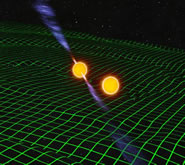
Neutron stars – the dense bodies of exploded stars – may merge more often, the discovery of a new system suggests. This increases the chances that astronomers will soon discover the elusive gravitational waves, the existence of which was predicted by Einstein.
The two newly discovered neutron stars are orbiting each other at unprecedented speed and in the closest orbit ever observed. The discovery raises the possibility that mergers between neutron stars may be ten times more common than previously thought.
Previous estimates suggested that violent collisions between neutron stars occur only once every billion years in our galaxy.
"So far the estimate of the rate of mergers has been somewhat pessimistic," says Nici D'Amico, an astronomer at the University of Cagliari in Italy and one of the team members. "The discovery implies that the rate of mergers is significantly high."
Only five systems of two neutron stars have been previously recorded. Based on their orbits and the distance between them, astronomers estimated that neutron star mergers would generate detectable gravitational waves once every 10 to 20 years. The latest discovery raises the rate to once a year or two.
"Gravitational waves are one of the greatest challenges of elementary physics nowadays," writes A. P. third'. van den Juvel, an astronomer at the University of Amsterdam in the Netherlands, in a commentary article, which accompanies the article in Nature. "No one has yet discovered them directly, but the chances of that have just improved."
Gravitational waves are an elusive phenomenon, predicted by Einstein's theory of general relativity.
These waves are thought to create ripples in the fabric of space-time, as fibrous objects move rapidly through space, similar to the way swimmers create waves in a pool. Astronomers believe that magical cataclysmic events such as supernovae or merging black holes or neutron stars create gravitational waves.
However, the waves were measured only indirectly. Russell A. Hulse and Joseph H. Taylor Jr. from Princeton University won the Nobel Prize in 1993 for their observation that the distance between a pair of neutron stars shrinks due to the energy carried by gravitational waves.
Despite their violent origin, gravitational waves will have almost no effect on Earth. Van den Juwel says that two neutron stars the size of our Sun, merging at a distance of one hundred million light years from Earth, will cause the oceans on Earth to move to a distance only ten times the width of an atomic nucleus.
Earth will be hit with slightly more force in eighty-five million years when the neutron stars merge, as the pair reside only a few thousand light-years away.
The swirling pair, discovered with the aid of the 2.4-meter Percus telescope in New South Wales, Australia, is located between the "Big Dog" and the constellation Puppies (stern?). They apparently orbit each other in a record time of XNUMX hours – three times faster than the previous record for double neutron stars.
D'Amico and his colleagues used the telescope to pinpoint the periodic signal of one of the stars, which is a pulsar. It sends a beam of radiation into space as it spins, similar to a lighthouse. Irregularities in the signal suggest that the pulsar is part of a two-star system, with each star slightly more massive than the Sun.
Astronomers hope that sensitive detectors such as the laser interferometer at the US Gravitational Wave Observatory or VIRGO in Italy may soon be able to measure these imperceptible gravitational waves.
Yadan Astrophysics 2 - stars and galaxies
https://www.hayadan.org.il/BuildaGate4/general2/data_card.php?Cat=~~~705895377~~~97&SiteName=hayadan
